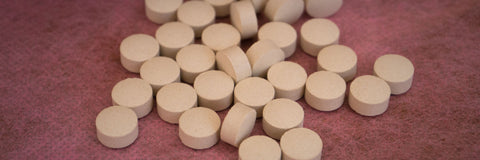
What Is The Best Methylfolate? Methylfolate Benefits Explained!

Written By:
Katie Stone - Naturopath
Medical Reviewer:
Jamie Hope - Founder of Methyl-Life
Edited By:
Kari Asadorian - Bachelor of Science in NursingUpdated On:
March 25, 2025Table of Contents
L-methylfolate is also known as:
Methylfolate may be referred to by many different names, including:
- L-MTHF
- L-5-Methylfolate
- L-5-Methylenetetrahydrofolate
- L-5-MTHF
- (6S)-5-Methylfolate
- (6S)-5-Methylenetetrahydrofolate
However, other terms can include:
- L-Methylfolate Calcium
- D-Methylfolate
- DL-Methylfolate
- D-5-Methyltetrahydrofolate
- DL-5-Methylenetetrahydrofolate
- 5-MTHF
- 5-Methylfolate
- (6R)-5-Methylfolate
- (6S)/(6R)-5-Methyltetrahydrofolate
NOTE: L or (6S) refers to the active isomer of methylfolate which is used by the human body. D or (6R) refers to the inactive isomer of methylfolate which the body does not use. Instead, this inactive insomer may actually "compete" with the active isomer for the receptor, and is not recommended by doctors. Be aware of companies who may be using these inactive (and cheaper) forms of methylfolate in their products and not labeling them properly.
Some well-known L-Methylfolate raw ingredients found in products include: Metafolin®, Extrafolate®, Quatrefolic®, Magnafolate®.
Some well-known ‘medical foods’ (or prescription nutrition products which contain L-Methylfolate) are: Deplin®, Enlyte®, Metanx®, Cerefolin®, Neevo®.
What is Deplin? What is Deplin Algal Oil?
Deplin is a prescription medication that is classified as a “medical food” rather than a drug.
It is essentially folate that has already been converted to L-methylfolate, so it is readily available for making serotonin, norepinephrine, and dopamine in the brain.
Deplin is available in 7.5 mg and 15 mg dosages.
What is Deplin Used For?
Deplin is used to treat people who have conditions related to folate deficiency. It’s particularly effective for those with major depressive disorder, schizophrenia, or hyperhomocysteinemia.
Folate is required for the synthesis of key brain chemical messengers including serotonin, norepinephrine, and dopamine. Low levels of these chemicals are implicated in major depression and other psychiatric disorders, which is why folate deficiency is linked with depression. Only L-methylfolate can pass through the “blood-brain barrier” and enter the central nervous system.
For people with a MTHFR mutation (around half the world's population) dietary folate or folic acid supplements will be ineffective because their body cannot convert it into active folate. This is why L-methylfolate supplements may help those with mood disorders.
Recent research has found that combining Deplin with a serotonin reuptake inhibitor (such as Zoloft or Paxil) can improve the response rate1 to the antidepressant more than two-fold.
Using Deplin and an antidepressant together has also been shown to improve symptoms by up to 84 percent over using the antidepressant alone.
What are the Active Ingredients in Deplin?
Each DEPLIN® capsule contains 7.5 mg or 15 mg of L-methylfolate (from Metafolin®)* and 90.314 mg of Algae-S powder (Schizochytrium).
What is the Difference Between Deplin and Deplin Algal Oil?
Deplin ingredients are a combination of the trademarked L-methylfolate (Metafolin®) and an algae called Schizochytrium, or algal oil.
Algal oil is made from marine algae. It is a source of important omega-3 fatty acids including docosahexaenoic acid (DHA) and eicosapentaenoic acid (EPA). Algal oil is used in foods and as a medicine.
Taking DHA during pregnancy and/or lactation has been found2 to improve gestation in high-risk pregnancies, increase overall size, and enhance visual acuity, hand and eye coordination, attention, problem solving and information processing.
What is the Difference Between L-Methylfolate vs Deplin?
Deplin® is a prescription medication but is classified as a “medical food” rather than a drug. It is generally prescribed to those with distinct nutritional requirements due to suboptimal L-methylfolate levels in the CSF, plasma, and/or red blood cells.
Deplin® is essentially folate that has already been converted into L-methylfolate, so it is readily available for making serotonin, norepinephrine, and dopamine in the brain. Those with major depressive disorder are often prescribed Deplin® if they have had no favorable response to antidepressant medications.
L-Methylfolate is a supplement that can be purchased over-the-counter. It is often used as a Deplin® over the counter equivalent, and is also recommended for those with folate deficiency or treatment-resistant depression.
What is the Difference between L-Methylfolate and Prescription Deplin®?
Deplin® is regulated by the US Food and Drug Administration (FDA). It can only be purchased with a prescription from your doctor.
If you are looking for a Deplin® substitute or Deplin® OTC, your best bet is to try high-quality L-methylfolate supplements.
These are available online and in health stores. There are many brands manufacturing L-methylfolate supplements and each formula may vary in terms of potency, quality, and the range of ingredients.
Is L-Methylfolate the Over-the-Counter Equivalent to Deplin®? Can it be a Substitute for Deplin®?
There are some highly effective Deplin® alternatives available over-the-counter.
L-Methylfolate (7.5 mg and 15 mg) may be an effective Deplin® OTC equivalent. This dosage has been shown in several studies to enhance antidepressant response.
One double-blind, placebo-controlled trial of L-methylfolate involving folate-deficient patients with major depression found that adding L-methylfolate 7.5 mg or 15 mg to standard treatment significantly improved3 patients’ recovery, both clinically and socially.
Some of the best-selling methylfolate supplements for depression are the Methyl-Life™ product range, including Methylfolate 7.5+, Methylfolate 10, Methylfolate 15 and Methylfolate 15+. These formulas are designed to support the body’s requirements for energy production and neurotransmitter synthesis while restoring healthy levels of folate.
Methyl-Life’s™ Methylfolate 15 contains a high dose (15 mg) of internationally-patented Magnafolate® PRO which recently proved to be 3x more pure than the other leading patented brands in a 60-day open air comparison study4.
This internationally-patented L-5-Methylfolate is crystalline calcium salt-based for superior stability and absorption. It is especially effective in people with an increased need for bioavailable folate due to genetic (MTHFR) defects, dietary deficiencies or those taking warfarin, coumadin, metformin, etc.
EnLyte® vs Deplin®
Like Deplin® is a FDA-regulated prescription medication containing L-methylfolate, the active dietary form of the vitamin B9 (folate).
EnLyte® also holds the FDA USP for dissolution and degradation of folates. This is an FDA standard claimed by only about a third of folate supplements.
Deplin® contains L-methylfolate calcium, while EnLyte® contains L-methylfolate magnesium. EnLyte® also contains folinic acid and citrated folacin, which are the three forms of folate proven effective in treating depression as cited in the Fava study.
Deplin® vs Metanx®
Deplin® contains L-methylfolate (from Metafolin®) and Algae-S powder (Schizochytrium).
Metax® contains L-methylfolate calcium (as Metafolin®), algae-S powder (Schizochytrium), pyridoxal-5'-phosphate (active B6), and methylcobalamin (active B12).
Both are prescription medical foods given to patients to treat conditions related to folate deficiency. Metanx® is generally used to treat patients with diabetic peripheral neuropathy. It is specially formulated to meet the distinctive nutritional requirements for this condition.
Deplin®, on the other hand, is used for the clinical dietary management of depression and schizophrenia.
Deplin® vs Generic Folate
The cost of Deplin® and other prescription medications can make it unaffordable for some, especially those who don't have health insurance. And even many who do have insurance afford it through the pharmacy (due to its ‘medical food’ and not ‘drug’ classification).
There are numerous alternatives to Deplin® available as OTC supplements. It’s important to check the ingredient lists of a supplement to find out which form of folate or L-methylfolate it contains, the dosage, and any other ingredients that may be present.
Let's compare the best-known brands on the market
Our Customer Success Story:
"I have been selling methylfolate since 2012, long before most people had ever heard of it. I was convinced not only by the science but also by my own personal journey. My serotonin levels went from 85 to 136 within a 3 month period of taking approximately 6 mg of methylfolate a day (the normal range for serotonin is 125-185). Methylfolate has changed my life."
-
 1. Does methylfolate have to be patented?
1. Does methylfolate have to be patented?
If a nutrient is patented, the company that owns it has the exclusive right to stop others from commercially using it. This simply means that the company has invested a lot of time and research into that nutrient - a good sign that it is high quality. However, this doesn't mean that a non-patented nutrient isn't as good. -
 2. Why is Methyl-Life's methylfolate the best?
2. Why is Methyl-Life's methylfolate the best?
First of all, the manufacturer of our methylfolate has developed a proprietary process for micronizing the molecule size of this methylfolate by using sonification instead of the typical grinding process. This means that Magnafolate® PRO has fewer impurities than other methylfolates. The industry USP standard requires no more than 2.5% impurities for methylfolate and many leading brands test at 0.9% impurities when measured. However, our methylfolate averages 0.2-0.3% total impurities, making it three times more pure than the other leading versions available today. -
 3. Why is Methyl-Life's methylfolate chemically superior?
3. Why is Methyl-Life's methylfolate chemically superior?
Many of the top three patented methylfolates use a version of methylfolate with the 6S isomer. This is also labeled as L or 6S (which is chemically identical). This version should have no inactive 6R isomer in it, but some non-patented versions may actually contain this inactive part of methylfolate. DL-5-methylfolate is the chemical term for a racemic version which is only partially active, but many will not label their methylfolate with these details. You'll need to see a Certificate of Analysis to determine this. Often the raw ingredient is 4+ times less expensive, which could explain why a product is cheaper. -
 4. What about the stability and potency?
4. What about the stability and potency?
Methyl-Life's methylfolate is built on a crystalline calcium salt molecule structure which makes it the most stable in the industry. Only two patented methylfolates are built on this same structure. It has excellent stability, with potency loss occurs of only f 1-2% per year: amorphous salt versions can lose up to 16% potency per year. -
 5. Does the salt type of methylfolate matter?
5. Does the salt type of methylfolate matter?
Methylfolate is available as either glucosamine salt or calcium salt. Methyl-Life uses the calcium salt based methylfolate because it’s more stable and similar to the pharmaceutical brand. If you have a negative reaction to your methylfolate, it may be due to the salt type. Try a version built on the calcium salt type (or vice versa) to see if your tolerance is better. -
 6. Does a long shelf life mean a better product?
6. Does a long shelf life mean a better product?
A long shelf life indicates that a nutrient is stable and potent. When a number of Methyl-Life products were tested five years after their manufacture date, the products were still fully potent according to the Supplement Facts. We compared these results to the products of another leading brand (that were also five years old) and found that they were no longer fully potent. -
 7. How do you know which brand to trust?
7. How do you know which brand to trust?
Look for a company's backstory: their 'why'. I am the owner of Methyl-Life. I have a genetic condition requiring me to take methylfolate for the rest of my life, and I wanted to know that I was taking the very best. I spent a lot of time researching and trying different brands before discovering the patented methylfolate I now use in all our products. I wanted to share my discoveries with other people who are affected by genetic conditions so that they too can experience these life-changing health benefits. Methyl-Life is a family-owned business that "takes its own medicine" and sells products with the best methylfolate on the planet.
Product Recommendations
5 Methylfolate: 5-mthf L-Methylfolate 5 mg
$44.00
- Bioactive 5 Methylfolate That Crosses Blood-Brain Barrier 3
- Supports Cardiovascular Function 5 & Brain Health 4
- 3rd-Party Tested for Purity, Potency & Safety
- 90 Vegan, Non-GMO, Chewable Mint Tablets
References
-
Lawrence D Ginsberg, Alondra Y Oubre, Yahya A DaouD; "L-methylfolate Plus SSRI or SNRI from Treatment Initiation Compared to SSRI or SNRI Monotherapy in a Major Depressive Episode"; Innovations in clinical neuroscience; 2011 Jan
https://www.ncbi.nlm.nih.gov/pmc/articles/PMC3036555/
-
Nancy L Morse; "Benefits of Docosahexaenoic Acid, Folic Acid, Vitamin D and Iodine on Foetal and Infant Brain Development and Function Following Maternal Supplementation during Pregnancy and Lactation"; Nutrients; 2012 Jul
https://www.ncbi.nlm.nih.gov/pmc/articles/PMC3407995/
-
P S Godfrey, B K Toone, M W Carney, T G Flynn, T Bottiglieri, M Laundy, I Chanarin, E H Reynolds; "Enhancement of recovery from psychiatric illness by methylfolate"; Lancet; 1990 Aug
https://pubmed.ncbi.nlm.nih.gov/1974941/
-
Methyl-Life® | Methyl-Life 60-day Methylfolate Comparison
https://cdn.shopify.com/s/files/1/0264/6369/9018/files/Methyl-Life_60-day_Methylfolate_Comparison.pdf?v=1595292111

About the Author
Katie is a qualified Naturopath (BNatMed) and freelance writer from New Zealand. She specializes in all things health and wellness, particularly dietary supplements and nutrition. Katie is also a dedicated runner and has completed more half-marathons than she can count!
Related Articles

Methylfolate and Depression
Written By: Katie Stone - Naturopath

Like what you read?
Please subscribe to get more content like this sent to your inbox.
Share This Article
Browse Categories
Product Recommendations
5 Methylfolate: 5-mthf L-Methylfolate 5 mg
$44.00





